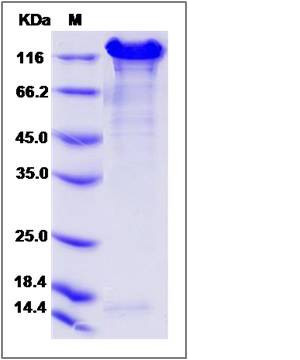Human E-Cadherin / CDH1 / E-cad / CD324 Protein (Fc Tag)
Arc-1,CD324,CDHE,E-cad,E-Cadherin,ECAD,LCAM,UVO
- 100ug (NPP3815) Please inquiry
| Catalog Number | P10204-H02H |
|---|---|
| Organism Species | Human |
| Host | Human Cells |
| Synonyms | Arc-1,CD324,CDHE,E-cad,E-Cadherin,ECAD,LCAM,UVO |
| Molecular Weight | The recombinant human E-Cad/Fc is a disulfide-linked homodimer. The reduced monomer comprises 791 amino acids and has a predicted molecular mass of 87.1 kDa. The apparent molecular mass of the protein is approximately 116-126 kDa in SDS-PAGE under reducing conditions. |
| predicted N | Gln 23 & Asp 155 |
| SDS-PAGE |  |
| Purity | > 90 % as determined by SDS-PAGE |
| Protein Construction | A DNA sequence encoding the human E-Cad (P12830)(Met1-Ile707) was expressed with the Fc region of human IgG1 at the C-terminus. |
| Bio-activity | Measured by the ability of the immobilized protein to support the adhesion of MCF-7 human breast adenocarcinoma cells. When cells are added to E-Cad coated plates (5 μg/mL, 100 μL/well), approximately 33% will adhere specifically after 90 minutes at 37 ℃. |
| Research Area | Cancer |Invasion microenvironment |Adhesion molecule |Cell adhesion |Cadherins |
| Formulation | Lyophilized from sterile PBS, pH 7.4. 1. Normally 5 % - 8 % trehalose and mannitol are added as protectants before lyophilization. Specific concentrations are included in the hardcopy of COA. |
| Background | Cadherins are calcium-dependent cell adhesion proteins which preferentially interact with themselves in a homophilic manner in connecting cells, and thus may contribute to the sorting of heterogeneous cell type. E-cadherin (E-Cad), also known as CDH1 and CD324, is a calcium-dependent cell adhesion molecule the intact function of which is crucial for the establishment and maintenance of epithelial tissue polarity and structural integrity. Mutations in CDH1 occur in diffuse type gastric cancer, lobular breast cancer, and endometrial cancer. In human cancers, partial or complete loss of E-cadherin expression correlates with malignancy. During apoptosis or with calcium influx, E-Cad is cleaved by the metalloproteinase to produce fragments of about 38 kDa (E-CAD/CTF1), 33 kDa (E-CAD/CTF2) and 29 kDa (E-CAD/CTF3), respectively. E-Cad has been identified as a potent invasive suppressor, as downregulation of E-cadherin expression is involved in dysfunction of the cell-cell adhesion system, and often correlates with strong invasive potential and poor prognosis of human carcinomas. |
| Reference |
